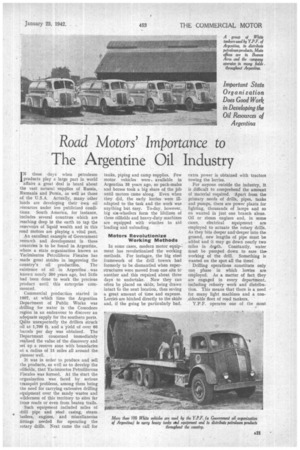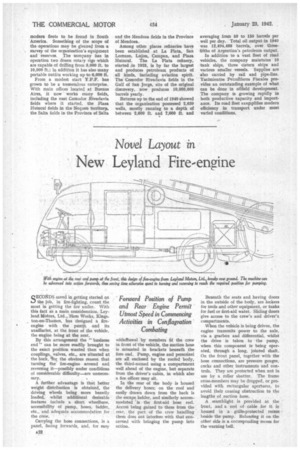Road Motors' Importance to The Argentine Oil Industry
Page 23

Page 24

If you've noticed an error in this article please click here to report it so we can fix it.
IN these days when petroleum products play a large part in world affairs a great deal is heard about the vast natural supplies of Russia, Rumania and Persia, as well as those of the U.S.A. Actually, many other lands are developing their own oil resources under less publicized conditions. South America, for instance, includes several countries which are reaching deep in the earth to tap the reservoirs of liquid wealth and in this road motors are playing a vital part.
An excellent example of Government research and development in these countries is to be found in Argentina, where a state organization known as Yacimientos Petroliferos Fiscales has made great strides in improving the country's oil production. The existence of oil in Argentina was known nearly 300 years ago, but little had been done to work the precious product until this enterprise commenced.
Commercial production started in 1907, at which time the Argentina Department of Public Works was drilling for water in the Comodoro region in an endeavour to discover an adequate supply for the southern ports. Quite unexpectedly the drillers struck oil at 1,700 ft. and a yield of over 60 barrels per day was obtained. The Department concerned immediately realized the value of the discovery and set up a reserve zone with boundaries at a radius of 15 miles all around the pioneer well.
It was in order to produce and sell the products, as well as -to develop the oilfields, that Yacimientos Petroliferous Fiscales was formed. At the start the organization was faced by serious transpert problems, among them being the need for carrying extensive drilling equipment over the sandy wastes and wilderness of this territory to sites far from, roads or even from beaten trails.
Such equipment included miles of drill pipe and steel casing, steam " boilers, engines, and miscellaneous fittings needed for operating the rotary drills. Next came the call for tanks, piping and camp supplies. Few motor vehicles were available in Argentina 85 years ago, so pack-mules and horses took a big share of the job until motors came along. Even when they did, the early lorries were illadapted to the task and the work was anything but easy. To-day, however, big six-wheelers form the lifelines of these oilfields and heavy-duty machines are equipped with winches to aid loading and unloading.
Motors Revolutionize Working Methods
In some cases, modern motor equipment has revolutionized the working methods. For instance, the big steel framework of the drill towers had formerly to be dismantled when superstructures were moved from one site to another and this required about three days to undertake. Now they can often be placed on skids, being drawn intact to the next location, thus saving a great amount of time and expense. Lorriei are hitched directly to the skids and, if the going be particularly bad,
extra power is obtained with tractors towing the lorries.
For anyone outside the industry, it is difficult to comprehend the amount of material required. -Apart from the primary needs of drills, pipes, tanks and pumps, there are power plants for lighting, thousands of lamps and so on wanted in just one branch alone. Oil or steam engines and, in some cases, electrical equipment are employed to actuate the rotary drills. As they bite deeper and-deeper into the ground, new lengths of pipe must be added and it may go down nearly two miles in depth. Constantly, water must be pumped down to ease theworking of the drill. Something is wanted on the spot all the time!
Drilling operations constitute only one phase in which lorries are employed. As a matter of fact they are engaged in every department, including refinery work and distribution. This means that there is a need for many light machines and a considerable fleet of road tankers.
Y.P.F. operates one of the most
modern fleets to be found in South America. Something of the scope of the operations may be gleaned from a survey of the organization's equipment and reserves. The company has in operation two dozen rotary rigs which are capable of drilling from 8,000 ft. to 10,000 ft.; in addition it has also many portable outfits working up to 6,000 ft.
From a modest start Y.P.F. has grown to be a tremendous enterprise. With main offices located at Buenos Aires, it now works many fields, including the vast C,omodor Rivadavia fields where it started, the Plaza Huincul fields in the Nequen territor3s, the Salta fields in the Province of Salta and the Mendoza fields in the Province of Mendoza.
Among other places refineries have been established at La Plata, San Lorenzo, Lnjon, Campan, and Plaza Huincul, The La Plata refinery, started in 1925, is by far the largest and produces petroleum products of all .kinds, including aviation spirit. The Comodor Rivadavia fields in the Gulf of San Jorge, site of the original discovery, now produces 10,000,000 barrels yearly.
Returns up to the end of 1940 showed that the organization possessed 2,639 wells, mostly running to a depth of between 2,600 ft. and 7,000 ft, and averaging from 50 to 150 barrels per well per day. Total oil output in 1940 was 12,494,488 barrels, over threefifths of Argentina's petroleum output.
In addition to a vast fleet of road vehicles, the company maintains 10 tank ships, three cistern ships and various smaller vessels. Supplies are also carried by rail and pipe-line. Yacimientos Petronieros Piscales provides an outstanding example of what can be done in oilfield development. The company is growing rapidly in both productive capacity and importance. Its road fleet exemplifiers modern efficiency in transport under most varied conditions.
























































